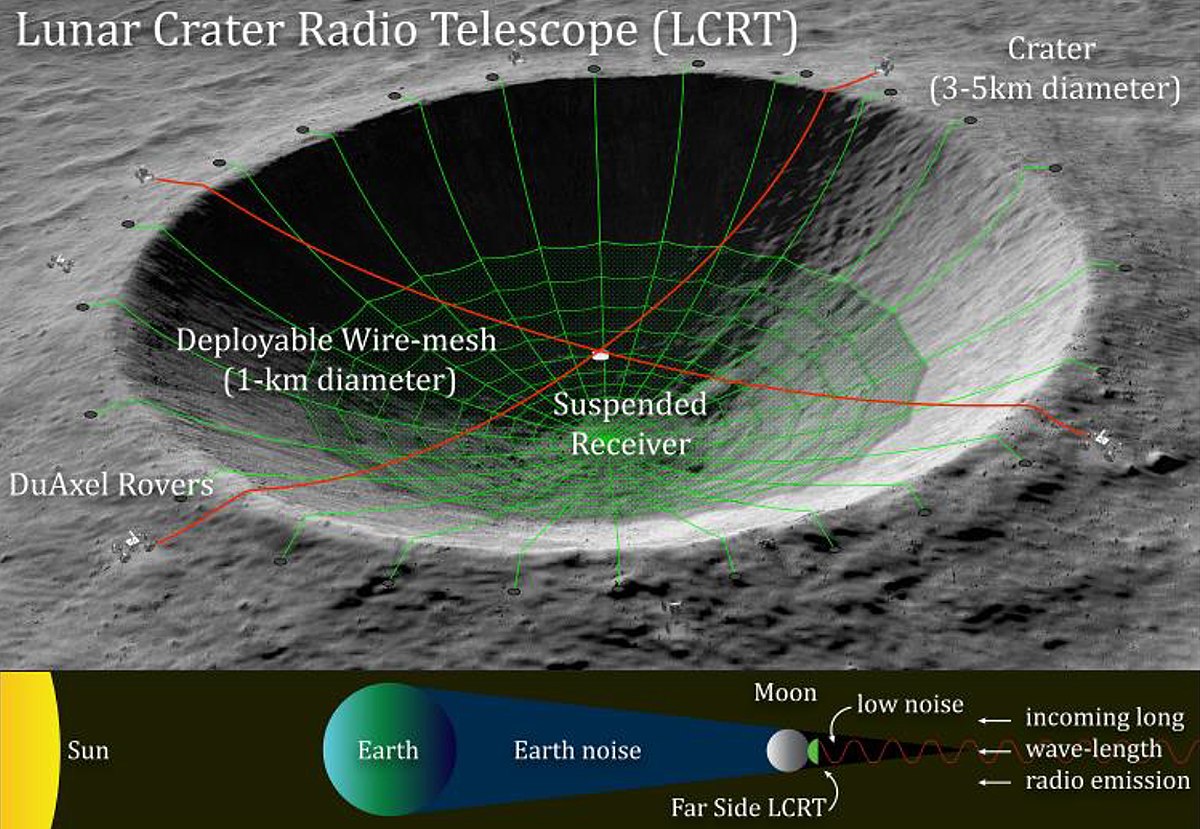For decades, astronomers have said that one of the most optimal places to build large telescopes is on the surface of the Moon. The Moon has several advantages over Earth- and space-based telescopes that make it worth considering as a future home for giant observatories. A new paper lists all the advantages, including how telescopes on the lunar surface wouldn’t be blocked by an atmosphere or impacted by wind, and how the low gravity would allow gigantic structures to be built that could be upgraded over time by astronauts.
“Progress on the big questions in astronomy, such as life on certain exoplanets or dark matter, will ultimately require high angular resolution, a large collecting area and access to the full optical spectrum,” write French astronomers Jean Schneider, Pierre Kervella, and Antoine Labeyrie. “All astronomy will benefit from the advantages provided by the localization on the Moon.”
And even though it might be decades before we have a permanent presence on the Moon, the astronomers suggest we should start with small telescopes now.

Over the years, scientists and engineers have proposed various ideas for lunar observatories as part of the NASA Innovative Advanced Concepts program. Back in 2005 there was a proposal for a deep-field infrared observatory near one of the lunar poles using a rotating liquid mirror. Earlier this year, a team from NASA’s Goddard Space Flight Center proposed a design for a lunar Long-Baseline Optical Imaging Interferometer (LBI) for imaging at visible and ultraviolet wavelengths. Additionally, astronomers have advocated building radio telescopes on the far side of the Moon, since this “radio-quiet” zone always faces away from Earth and would provide the perfect location to study a variety of astronomical phenomena that can’t be observed in low radio frequencies from our planet, or even by Earth-orbiting space telescopes.
In their new paper, Schneider, Kervella and Labeyrie say that Moon offers a combination of three distinct advantages for astronomical observing. Its lack of atmosphere allows access to the entire spectrum, including the visible, ultraviolet, and infrared. Astronomers wouldn’t have to deal with atmospheric turbulence, and the Moon’s low gravity and absence of wind make it possible to install extremely large telescopes with very large instruments. This is impossible for satellites in orbit. Additionally, telescopes on the Moon would allow for the instruments to be upgraded and to have a very long lifetime, which is impractical for space satellites due to their limited amount of fuel.
“The Moon offers the possibility of installing large telescopes or interferometers with instruments larger than those on orbiting telescopes,” the astronomers write.
Using a variety of observational techniques, from photometry to high contrast and high angular resolution imaging, the astronomers suggested several ambitious science cases that could be tackled, including observations of our own Solar System – including our own planet Earth — as well as distant exoplanets and possible exomoons. They add that very high angular resolution would allow for the imaging of exoplanet transits or even the stellar glint on exo-ocean.

In the extragalactic domain, telescopes on the Moon could allow for the study of the distribution of dark matter or observing the gravitational lensing of quasars. Other lunar telescopes could investigate the unexplored Dark Ages of the early universe, a time before and during the formation of the very first stars and galaxies.
The best location for a lunar telescope depends on two factors: the physical conditions of the site (temperature, soil quality, solar illumination) and its scientific objectives.
“For example, telescopes pointing towards Earth must be placed on the near side of the Moon,” they said. “From the point of view of target observability, they can be placed almost anywhere. At the lunar poles, only half the sky is visible, but all the time. At the lunar equator, the whole sky is visible, but only half the time. For observations of or towards the Earth, the optimum is not far from the lunar equator.”
However, putting observatories on the lunar surface does present several problems, including incessant dust, the proclivity for incoming meteoroids, or dealing with other surprises like lunar seismology (Moonquakes).
With the ultimate science goals above in mind, the astronomers said that a small 30 cm to 1 meter class telescope will explore significant science cases.
Even though this first lunar telescope would be a prototype, it would still be astronomically valuable. It could perform observations that would be complimentary to the James Webb Space Telescope or the Hubble Space Telescope. But for the future, a 20-meter mirror would provide resolution 3 times greater than the JWST, and by integrating, or leaving the “shutter” open for long periods, objects 100 times fainter could be observed.
Further reading: Astronomy from the Moon in the next decades: From Exoplanets to Cosmology in Visible Light and Beyond

